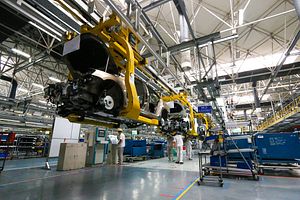Despite China’s downturn, its automobile industry is performing well, as may be surmised from the enthusiasm generated at the Beijing Auto Show and, of course, sales statistics. Auto sales have been on the rise, growing 4.7 percent in 2015 from 2014, with passenger cars making up the lion’s share of purchases. Auto sales have continued to increase in 2016, with particular growth in SUVs and new energy vehicles.
At the Beijing Auto Show, which has been open to the public since April 29 and will remain open through May 4, many new models, in particular new SUV models, were on display. Sales of SUVs, currently en vogue in China for their spaciousness and high seat positioning, expanded by 52 percent in 2015 and continue to grow. On display at the show was Volkswagen’s T-Prime Concept GTE crossover, which includes an electric motor and provides 87 miles per gallon, and incorporates a high-tech interior with an instrument panel and display set behind a curved panel. Also appearing was the Mazda CX-4 crossover, available only in China, which is more streamlined than the CX-5 but uses the same wheelbase. Many of the vehicles shown were local Chinese brands, which account for almost half of all vehicles produced in the nation.
SUVs have increased sales in recent months, particularly as Great Wall Motor and Chongqing Changan Automobile Co reduced prices on entry-level SUVs. SUV sales increased by 45 percent between 2014 and 2015, reaching 6 million vehicles in 2015, or one third of new passenger vehicle sales. New energy vehicles have increased sales from a low base, with eager new Chinese firms planning to enter the electric car market.
Government policy has boosted car sales, with a 50 percent cut in smaller engine sales tax in October of last year making vehicle purchases more attractive. The government is also providing state subsidies of up to 120,000 RMB for the purchase of electric cars until 2017 in order to reach a target of having five million electric cars on the roads by 2020. A government directive also requires banking institutions to lower the down payments for new energy vehicles, while another requests that public institutions add more NEVs to their car pools. The government is invested in ensuring that consumers obtain the best prices possible in general. Anti-monopoly law has been drafted to increase competition in the auto sector and improve conditions for the consumer.
China’s well-functioning auto sector is a bright spot in a dwindling economy. Automobile consumption boosts consumer spending, which China’s leadership is attempting to expand. Encouraging innovation and ensuring competition by reducing monopolistic practices continue to benefit the sector. Meanwhile, the participation of Chinese firms in vehicle production helps to ensure China’s viability in this global sector. While infrastructure, a necessary complement to vehicle use, may lag in some regions, China’s commitment to development and urbanization will ensure that roads and electric vehicle charging areas continue to expand. We can expect China’s auto industry to keep moving.
































